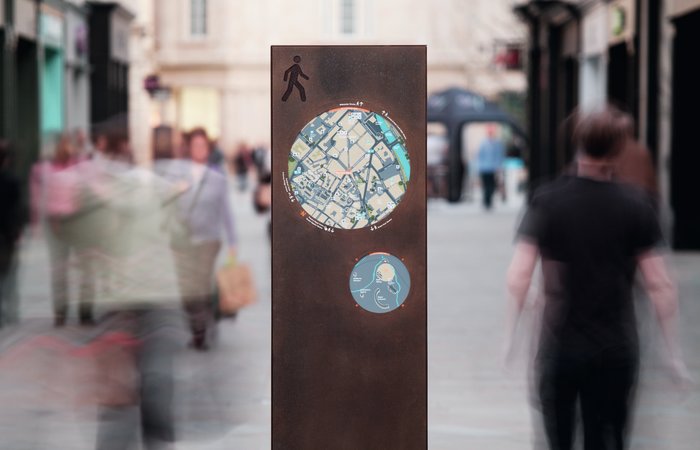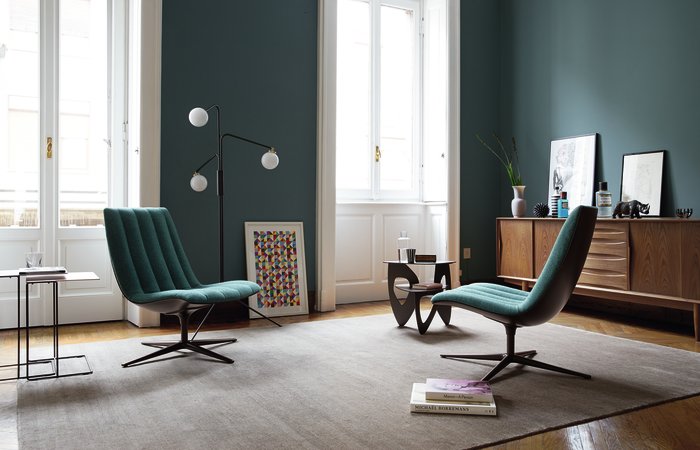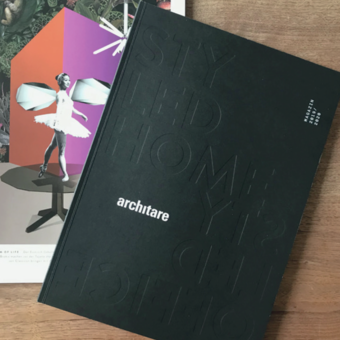Tom Lloyd (*1968) and Luke Pearson (*1967) have been contributing to the British design scene for more than 20 years. Both studied at the London Royal College of Art, where these days they teach as guest lecturers. Apart from their core work, which is furniture and product design, PearsonLloyd have specialised in public projects: a new street lighting system for the City of Westminster, urban information and control systems for Bath and Sheffield, and they are always developing products and concepts for aviation companies, office outfitters and for the health industry.
Tom & Luke - London Calling: visiting Pearson & Lloyd
Their customers include renowned firms like Artemide, Bene Classicon, Fritz Hansen, Walter Knoll, Poltrona Frau and Virgin Airlines. Lufthansa’s 747-8i fleet customers have been flying in a business class created by PearsonLloyd since 2012. With more than 70 awards, including prominent titles such as “Royal Designers for Industry” of the Royal Society of Arts, Tom Lloyd and Luke Pearson count among the highest endowed designers of the British Isles.
The two creative brains have been designated as being among the Top 50 designers that are creating the future by Fast Co. magazine in New York, since 2012. Barbara Benz was curious to know what the future looks like and visited the designer duo at their studio in Shoreditch in London. Lloyd: Yes, well. You’ll find all the disciplines here: fashion, graphic and industrial design. It’s almost ironic that Great Britain, and London, in particular, actually doesn’t have any industries. Pearson:
London is one of the few cities that unite politics, finance and creativity
These areas are separated in most cases – just look at Barcelona and Madrid or Frankfurt and Berlin, for example. Here in London the financial district and the creative hotspot are right next to each other and influence each other - positively.

In that case, it is beneficial for London to have a good design university?
Yes and no. Many people return to their countries after their studies and take their knowledge with them. That doesn’t really help us in the long term. On the other hand, more and more students are founding small start-ups, because they want to work independently and turn their own ideas into reality. London is a big magnet for young talent. This global diversity and energy can be clearly felt in the city. Our customers also love coming to London to see our design studio.
What differentiates PearsonLloyd from other design studios?
When we met each other 23 years ago, we had one common goal:
we wanted to do interdisciplinary work
In the 1980’s, particularly, it wasn’t customary for product designers to also design furniture. Product, furniture and fashion design were strictly separate. We wanted to unify the different disciplines in our work, as there wasn’t anything like that in England at the time…
How does one recognise the PearsonLloyd style?
That depends entirely on the type of project.
When we work on a design for an airline, for example, we are bound by numerous specifications. It is difficult to leave behind your own signature in that case. Our priority is to find elegant solutions. For that, details are decisvie. I think people look at our products because we invest a lot of time in the details.
What inspires you?
Lloyd: Everything. But you have to make time for yourself. Sometimes, when I’m working very hard, I forget to look and search for new inspiration. Yesterday I walked through London from Southwark to Piccadilly. It was truly one of the best hours I’ve spent in a long time. I took lots of photos and just absorbed the city. I went over the Hungerford Bridge past the National Theatre. I often walk that way, but this time I concentrated on the skateboarders. Some of them walked down to the Thames with broken skateboards. When I took a closer look I noticed that there were about 200 broken skateboards lying in an alley. It looked like a sculpture. It’s obviously a ritual for the skateboarders to dispose of their boards there.
Pearson: My father used to tell me “chin up”, as a child, when we went through the city together. I try to follow that simple advice, even today. Most people who walk through London look at each other sideways, or to the ground. But, if you actually look up, you discover how the sunlight, the images formed by clouds, or birds flying past can change your view on a building. You recognise new structures, new lines and much more.
What is your favourite material?
The next material! There are always new and different materials. I love my work, because every project is different. Our favourite project is also the one we’re starting on next. It’s like being in a garden: the flower that you’ve just planted is the most exciting.
Which materials could be used in 15-20 years from now?
Difficult to say. There are many different materials available today, but the price is decisive. I still regard wood and leather as among the best materials. You have a relationship with them, in comparison to plastic or aluminium.
What could the office of the future look like?
Lloyd: That depends on the type of work, and how technologies will continue to develop. Before you needed L- or X-shaped tables because of the shape and depth of computer screens. These days not even half of that space is used. Tablets, laptops and mini-PC’s have changed our workplace. We are better connected and can do the major part of our work via email or Skype conference, so that physical presence only plays a subordinate role in many areas of commerce. At the same time the home office is gaining in importance. In the USA they estimate that up to half of employees will work independently by 2020.
The new type of company will only need places or spaces in which they can get together and share ideas, instead of individual offices for engineers or mathematicians. These “Business Lounges” could also be shared by companies. While the previous generation still clings to familiar structures such as “nine to five”, the new generation already has a different relationship to work and to how one works. Pearson: Sustainability will become increasingly important, as there are no disadvantages to working sustainably.* Many people also have a growing connection to nature. Thus, plants and green oases in cities and offices will become more popular in future.

How does a trend develop if all designers claim to work independently and individually?
Basically, product and furniture designers are more arrogant than fashion designers, for example. In fashion it is more or less determined that dazzling colours will be used in a particular season, as an example. Thus, all the big fashion labels use dazzling colours. In contrast, product and furniture designers always think that they are inventing something completely new. But that’s a lie, as we are all influenced by history and the media. All of us follow “trends”, especially if we’re working on commercially orientated projects; we have to follow them.
Trends develop in a surprising way
Scriptwriters or film directors cannot plan to create a cult movie: only those who watch it can elevate it to that status.

Photos ©
Mark Cocksedge
Ted Reeve
Lufthansa
Emil Benz






